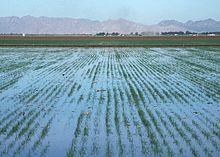DIFFERENT IRRIGATION SYSTEMS:-
General Information of Irrigation:-
Well and Tube Well Irrigation:-
1. Well Water Irrigation system:
Wells are mainly found in U. P., Bihar, Tamil Nadu, etc. there are various types of wells – shallow wells, deep wells, tube wells, artesian wells, etc. From the shallow wells water is not always available as the level of water goes down during the dry months. Deep wells are more suitable for the purpose of irrigation as water from them is available through out the year.
Tube-wells are also used for irrigation purposes. At places where ground water is available, a tube-well can be installed near the agricultural area. A deep tube well worked by electricity, can irrigate a much larger area (about 400 hectares) than a surface well (1/2 hectares). Tube wells are mostly used in U.P., Haryana, Punjab, Bihar and Gujarat. In Rajasthan and Maharashtra, artesian wells are now supplying water to agricultural lands. In artesian wells, water level remains at a high-level because of the natural flow of water due to high pressure.
2. Tank Water Irrigation system:
In the Deccan, water-reservoirs are made by constructing dams. This system is greatly adopted in the States of Tamil Nadu, Andhra Pradesh, and Karnataka, etc. In Northern India also, tanks are constructed for storing water. From all these tanks, water is carried to the fields through canals. In many places, rain-water harvesting systems are installed and water is stored in large artificial reservoirs to be used for agricultural purposes.
3. Inundation Irrigation system:
Canal irrigation is playing a vital role in Indian agriculture. It canal near about 42% of total irrigated land. In many places during the rainy season, there is flood in the rivers. The flood water is carried to the field through canals. These canals are found in W.B., Bihar, Orissa, etc. They supply water only when there is flood in the rivers, and therefore, are of no use during the dry season when water is required most.
4. Perennial Canals Irrigation System:
The perennial canals get the supply of water either from the river directly or through the reservoirs of the river projects. In order to supply water throughout the year, reservoirs are constructed for storing water. From these reservoirs, water can be supplied to the fields whenever there is demand for it. So this system of irrigation ensures supply of water in all season. This type of perennial canal is found mostly in Punjab, U.P., and Tamil Nadu.
In Punjab, the upper Bari Doab canal connecting the Ravi and the Beas and Sirhind (from the Sutlej) canal is famous. In U.P., the Upper Ganga and the Lower Ganga canals, Agra and Sarda canals, etc. are important. In Tamil Nadu, most important are the Buckingham canal and the Periyar canal.
5. Multi-Purpose River Valley Projects :
In recent years, multi-purpose river valley projects are helping agriculture. The most important are:
• the Damodar Valley Project in West Bengal,
• the Mor (Mayurakshi) Project in West Bengal,
• the Mahanadi (Hirakud) Project in Orissa,
• the Kosi Project in Bihar, and
• the Bhakra Nangal Project in Punjab.
Irrigation scheduling:-
Irrigation scheduling is the process by which an irrigator determines the timing and quantity of water to be applied to the crop or pasture. The challenge is to estimate crop water requirements for different growth stages and climatic conditions.
To avoid over or under watering, it is important to know how much water is available to the plant, and how efficiently the plant can use it. The methods available to measure this include.
Over or under watering problems:
While irrigation has provided a number of important benefits there can be potential drawbacks of over or under watering.
Under-watering can cause:
loss in market value through yield reduction
reduction in fruit size and quality.
Over-watering can cause.
--------------------------------------------------------------------------------------------------------------------------------------
Irrigation in India

An irrigation canal in Gujarat.
Irrigation in India includes a network of major and minor canals from Indian rivers, groundwater well based systems, tanks, and other rainwater harvesting projects for agricultural activities. Of these groundwater system is the largest. In 2010, only about 35% of total agricultural land in India was reliably irrigated. About 2/3rd cultivated land in India is dependent on monsoons. Irrigation in India helps improve food security, reduce dependence on monsoons, improve agricultural productivity and create rural job opportunities. Dams used for irrigation projects help produce electricity and transport facilities, as well as provide drinking water supplies to a growing population, control floods and prevent droughts.
History
Ancient India
The earliest mentions of irrigation are found in Rigveda chapters 1.55, 1.85, 1.105, 7.9, 8.69 and 10.101. The Veda mentions only well-style irrigation, where kupa and avata wells once dug are stated to be always full of water, from which varatra (rope strap) and cakra (wheel) pull kosa (pails) of water. This water was, state the Vedas, led into surmi susira (broad channels) and from there into khanitrima (diverting channels) into fields.
Later, the 4th-century BCE Indian scholar Pāṇini, mentions tapping several rivers for irrigation. The mentioned rivers include Sindhu, Suvastu, Varnu, Sarayu, Vipas and Chandrabhaga. Buddhist texts from the 3rd century BCE also mention irrigation of crops. Texts from the Maurya Empire era (3rd century BCE) mention that the state raised revenue from charging farmers for irrigation services from rivers.
Patanjali, in Yogasutra of about the 4th century CE, explains a technique of yoga by comparing it to "the way a farmer diverts a stream from an irrigation canal for irrigation". In Tamil Nadu, the Grand Anicut (canal) across the Kaveri river was implemented in the 3rd century CE, and the basic design is still used today.
Islamic era
Waterworks were undertaken during the Delhi Sultanate and the Mughal Empire era from the 12th to 18th centuries. However, these were primarily to supply water to the palaces and parks of the sultans and other officials.
Colonial era
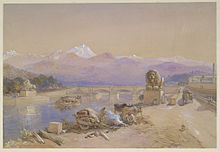
Ganges irrigation canal built during the colonial era, and inaugurated in 1854.
In 1800, some 800,000 hectares was irrigated in India. The British Raj by 1940 built significant number of canals and irrigation systems in Uttar Pradesh, Bihar, Punjab, Assam and Orissa. The Ganges Canal reached 350 miles from Haridwar to Kanpur in Uttar Pradesh. In Assam, a jungle in 1840, by 1900 had 4,000,000 acres under cultivation, especially in tea plantations. In all, the amount of irrigated land multiplied by a factor of eight. Historian David Gilmour states British colonial government had built irrigation network with Ganges canal and that, "by the end of the century the new network of canals in the Punjab" were in place.
Much of the increase in irrigation during British colonial era was targeted at dedicated poppy and opium farms in India, for exports to China. Poppy cultivation by the British Raj required reliable, dedicated irrigation system. Large portions of the eastern and northern regions of India, namely United Provinces, Northwestern Provinces, Oudh, Behar, Bengal and Rewa were irrigated to ensure reliable supply of poppy and opium for China. By 1850, the Asian opium trade created nearly 1,000 square kilometers of poppy farms in India in its fertile Ganges plains, which increased to over 500,000 acres by 1900. This diversion of food crop land to cash crop use, state scholars, led to massive famines over the 1850 to 1905 period.
Major irrigation canals were built after millions of people died each in a series of major famines in the 19th century in British India.
In 1900, British India (including Bangladesh and Pakistan) had about 13 million ha under irrigation. In 1901 the Viceroy, Lord Curzon, appointed a Commission chaired by Sir Colin Scott-Moncrieff to draw up a comprehensive irrigation plan for India. In 1903 the Commission's report recommended irrigation of an additional 2.6 million hectares. By 1947, the irrigated area had increased to about 22 million ha. In Northwestern British India region alone, with the colonial government's effort, 2.2 million hectares of previously barren land was irrigated by 1940s, most of which is now part of Pakistan. Arthur Cotton led some irrigation canal projects in the Deccan peninsula, and landmarks are named after him in Andhra Pradesh and Tamil Nadu. However, much of the added irrigation capacity during the colonial era was provided by groundwater wells and tanks, operated manually.
Irrigation trends since 1947

One of the sections of Bhakra Canal system in north India. This canal network irrigates over 4 million hectares of land.
India's irrigation covered crop area was about 22.6 million hectares in 1951, and it increased to a potential of 90 mha at the end of 1995, inclusive of canals and groundwater wells. However, the potential irrigation relies of reliable supply of electricity for water pumps and maintenance, and the net irrigated land has been considerably short. According to 2001/2002 Agriculture census, only 58.1 million hectares of land was actually irrigated in India. The total arable land in India is 160 million hectares (395 million acres). According to the World Bank, only about 35% of total agricultural land in India was reliably irrigated in 2010.
The ultimate sustainable irrigation potential of India has been estimated in a 1991 United Nations' FAO report to be 139.5 million hectares, comprising 58.5 mha from major and medium river-fed irrigation canal schemes, 15 mha from minor irrigation canal schemes, and 66 mha from groundwater well fed irrigation.
India's irrigation is mostly groundwater well based. At 39 million hectares (67% of its total irrigation), India has the world's largest groundwater well equipped irrigation system (China with 19 mha is second, USA with 17 mha is third). India has spent ₹ 16,590 crore on irrigation development between 1950 and 1985. Between 2000-2005 and 2005-2010, India proposed to invest a sum of ₹ 1,03,315 crore and 2,10,326 crore on irrigation and flood control in India.
State-wise irrigation types, capacity and actual :
| State | Total crop area (2011) (million hectares) |
Groundwater irrigation equipped crop area (2011) (million hectares) |
Canal irrigation equipped crop area (2011) (million hectares) |
Total crop area actually irrigated (2011) (million hectares) |
| Andhra Pradesh | 14.3 | 2.5 | 2.7 | 4.9 |
| Arunachal Pradesh | 0.4 | 0.07 | 0.05 | |
| Assam | 3.0 | 0.13 | 0.1 | 0.22 |
| Bihar | 6.4 | 2.2 | 1.3 | 3.5 |
| Chhattisgarh | 5.1 | 0.17 | 0.74 | 0.85 |
| Goa | 0.1 | 0.1 | 0.1 | |
| Gujarat | 9.9 | 3.1 | 0.5 | 3.2 |
| Haryana | 3.6 | 1.99 | 1.32 | 3.26 |
| Himachal Pradesh | 1.0 | 0.02 | 0.09 | 0.11 |
| Jammu & Kashmir | 0.9 | 0.02 | 0.38 | 0.37 |
| Jharkhand | 3.2 | 0.11 | 0.13 | 0.24 |
| Karnataka | 12.2 | 1.43 | 1.33 | 2.38 |
| Kerala | 1.5 | 0.18 | 0.21 | 0.39 |
| Madhya Pradesh | 15.8 | 2.74 | 1.70 | 4.19 |
| Maharashtra | 19.8 | 3.12 | 1.03 | 3.36 |
| Manipur | 0.2 | 0.05 | 0.05 | |
| Meghalaya | 0.3 | 0.06 | 0.06 | |
| Mizoram | 0.1 | 0.01 | 0.01 | |
| Nagaland | 1.1 | 0.1 | 0.07 | |
| Odisha | 4.9 | 0.17 | 1.07 | 1.24 |
| Punjab | 4.0 | 3.06 | 0.94 | 3.96 |
| Rajasthan | 21.1 | 3.98 | 1.52 | 5.12 |
| Sikkim | 0.1 | 0.01 | 0.01 | |
| Tamil Nadu | 6.5 | 1.61 | 1.43 | 2.66 |
| Tripura | 0.3 | 0.02 | 0.05 | 0.07 |
| Uttar Pradesh | 17.6 | 10.64 | 4.21 | 14.49 |
| Uttarakhand | 0.8 | 0.22 | 0.14 | 0.35 |
| West Bengal | 5.5 | 2.09 | 1.22 | 2.98 |
| All India | 159.6 | 39.43 | 22.48 | 58.13 |
Note: The all India total includes land area for Union Territories of India that is not shown in the above table.
Project classification

An irrigation canal in western Rajasthan.
Irrigation Projects in India are classified on three major aspects into:[citation needed]
1. Minor Irrigation Projects
2. Medium Irrigation Projects
3. Major Irrigation Projects Since 1950, irrigation works were classified on the basis of cost incurred for the projects' implementation, governing and dissemination., However, the Planning Commission of India adopted the classification of projects on the basis of culturable command area(CCA).
--------------------------------------------------------------------------------------------------------------------------------------
Irrigation in World
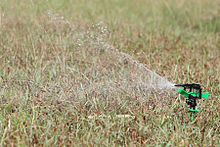
An irrigation sprinkler watering a lawn
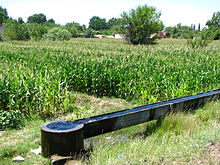
Irrigation canal in Osmaniye, Turkey
Irrigation is the method in which a controlled amount of water is supplied to plants at regular intervals for agriculture. It is used to assist in the growing of agricultural crops, maintenance of landscapes, and revegetation of disturbed soils in dry areas and during periods of inadequate rainfall. Additionally, irrigation also has a few other uses in crop production, which include protecting plants against frost, suppressing weed growth in grain fields and preventing soil consolidation. In contrast, agriculture that relies only on direct rainfall is referred to as rain-fed or dry land farming.
Irrigation systems are also used for dust suppression, disposal of sewage, and in mining. Irrigation is often studied together with drainage, which is the natural or artificial removal of surface and sub-surface water from a given area.
Irrigation has been a central feature of agriculture for over 5,000 years and is the product of many cultures. Historically, it was the basis for economies and societies across the globe, from Asia to the Southwestern United States.
History

Animal-powered irrigation, Upper Egypt, ca. 1846

Inside a karez tunnel at Turpan, Sinkiang

irrigation in Tamil Nadu, India

Crop sprinklers near Rio Vista, California
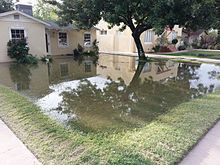
Residential flood irrigation in Phoenix, Arizona in the United States of America.
Archaeological investigation has found evidence of irrigation where the natural rainfall was insufficient to support crops for rainfed agriculture.Perennial irrigation was practiced in the Mesopotamian plain whereby crops were regularly watered throughout the growing season by coaxing water through a matrix of small channels formed in the field. Ancient Egyptians practiced Basin irrigation using the flooding of the Nile to inundate land plots which had been surrounded by dykes. The flood water was held until the fertile sediment had settled before the surplus was returned to the watercourse. There is evidence of the ancient Egyptian pharaoh Amenemhet III in the twelfth dynasty (about 1800 BCE) using the natural lake of the Faiyum Oasis as a reservoir to store surpluses of water for use during the dry seasons, the lake swelled annually from flooding of the Nile.
China
The oldest known hydraulic engineers of China were Sunshu Ao (6th century BCE) of the Spring and Autumn period and Ximen Bao (5th century BCE) of the Warring States period, both of whom worked on large irrigation projects. In the Sichuan region belonging to the State of Qin of ancient China, the Dujiangyan Irrigation System was built in 256 BCE to irrigate an enormous area of farmland that today still supplies water. By the 2nd century AD, during the Han Dynasty, the Chinese also used chain pumps that lifted water from lower elevation to higher elevation. These were powered by manual foot pedal, hydraulic waterwheels, or rotating mechanical wheels pulled by oxen. The water was used for public works of providing water for urban residential quarters and palace gardens, but mostly for irrigation of farmland canals and channels in the fields.
Korea
In 15th century Korea, the world's first rain gauge, uryanggye (Korean), was invented in 1441. The inventor was Jang Yeong-sil, a Korean engineer of the Joseon Dynasty, under the active direction of the king, Sejong the Great. It was installed in irrigation tanks as part of a nationwide system to measure and collect rainfall for agricultural applications. With this instrument, planners and farmers could make better use of the information gathered in the survey.
North America
Main article: Hohokam
The earliest agricultural irrigation canal system known in the U.S. dates to between 1200 B.C. and 800 B.C. and was discovered in Marana, Arizona (adjacent to Tucson) in 2009. The irrigation canal system predates the Hohokam culture by two thousand years and belongs to an unidentified culture. In North America, the Hohokam were the only culture known to rely on irrigation canals to water their crops, and their irrigation systems supported the largest population in the Southwest by AD 1300. The Hohokam constructed an assortment of simple canals combined with weirs in their various agricultural pursuits. Between the 7th and 14th centuries, they also built and maintained extensive irrigation networks along the lower Salt and middle Gila rivers that rivaled the complexity of those used in the ancient Near East, Egypt, and China. These were constructed using relatively simple excavation tools, without the benefit of advanced engineering technologies, and achieved drops of a few feet per mile, balancing erosion and siltation. The Hohokam cultivated varieties of cotton, tobacco, maize, beans and squash, as well as harvested an assortment of wild plants. Late in the Hohokam Chronological Sequence, they also used extensive dry-farming systems, primarily to grow agave for food and fiber. Their reliance on agricultural strategies based on canal irrigation, vital in their less than hospitable desert environment and arid climate, provided the basis for the aggregation of rural populations into stable urban centers.
-------------------------
Present extent
-------------------------
In the mid-20th century, the advent of diesel and electric motors led to systems that could pump groundwater out of major aquifers faster than drainage basins could refill them. This can lead to permanent loss of aquifer capacity, decreased water quality, ground subsidence, and other problems. The future of food production in such areas as the North China Plain, the Punjab, and the Great Plains of the US is threatened by this phenomenon.
At the global scale, 2,788,000 km² (689 million acres) of fertile land was equipped with irrigation infrastructure around the year 2000. About 68% of the area equipped for irrigation is located in Asia, 17% in the Americas, 9% in Europe, 5% in Africa and 1% in Oceania. The largest contiguous areas of high irrigation density are found:
• In Northern India and Pakistan along the Ganges and Indus rivers
• In the Hai He, Huang He and Yangtze basins in China
• Along the Nile river in Egypt and Sudan
• In the Mississippi-Missouri river basin and in parts of California
Smaller irrigation areas are spread across almost all populated parts of the world.
Only eight years later in 2008, the scale of irrigated land increased to an estimated total of 3,245,566 km² (802 million acres), which is nearly the size of India.
Types of irrigation
Basin flood irrigation of wheat

Irrigation of land in Punjab, Pakistan
Various types of irrigation techniques differ in how the water obtained from the source is distributed within the field. In general, the goal is to supply the entire field uniformly with water, so that each plant has the amount of water it needs, neither too much nor too little.
Surface irrigation
In surface (furrow, flood, or level basin) irrigation systems, water moves across the surface of agricultural lands, in order to wet it and infiltrate into the soil. Surface irrigation can be subdivided into furrow, border strip or basin irrigation. It is often called flood irrigation when the irrigation results in flooding or near flooding of the cultivated land. Historically, this has been the most common method of irrigating agricultural land and still used in most parts of the world.
Where water levels from the irrigation source permit, the levels are controlled by dikes, usually plugged by soil. This is often seen in terraced rice fields (rice paddies), where the method is used to flood or control the level of water in each distinct field. In some cases, the water is pumped, or lifted by human or animal power to the level of the land. The field water efficiency of surface irrigation is typically lower than other forms of irrigation but has the potential for efficiencies in the range of 70% - 90% under appropriate management.
Localized irrigation
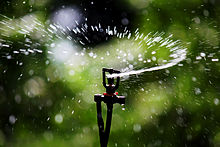
Impact sprinkler head
Localized irrigation is a system where water is distributed under low pressure through a piped network, in a pre-determined pattern, and applied as a small discharge to each plant or adjacent to it. Drip irrigation, spray or micro-sprinkler irrigation and bubbler irrigation belong to this category of irrigation methods.
Subsurface textile irrigation

Diagram showing the structure of an example SSTI installation
Subsurface Textile Irrigation (SSTI) is a technology designed specifically for subsurface irrigation in all soil textures from desert sands to heavy clays. A typical subsurface textile irrigation system has an impermeable base layer (usually polyethylene or polypropylene), a drip line running along that base, a layer of geotextile on top of the drip line and, finally, a narrow impermeable layer on top of the geotextile (see diagram). Unlike standard drip irrigation, the spacing of emitters in the drip pipe is not critical as the geotextile moves the water along the fabric up to 2 m from the dripper.
Drip irrigation
Drip irrigation layout and its parts

Drip irrigation – a dripper in action
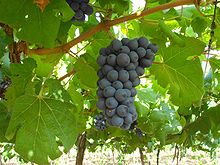
Grapes in Petrolina, only made possible in this semi arid area by drip irrigation
Drip (or micro) irrigation, also known as trickle irrigation, functions as its name suggests. In this system water falls drop by drop just at the position of roots. Water is delivered at or near the root zone of plants, drop by drop.
This method can be the most water-efficient method of irrigation, if managed properly, since evaporation and runoff are minimized. The field water efficiency of drip irrigation is typically in the range of 80 to 90 percent when managed correctly.
In modern agriculture, drip irrigation is often combined with plastic mulch, further reducing evaporation, and is also the means of delivery of fertilizer. The process is known as fertigation.
Deep percolation, where water moves below the root zone, can occur if a drip system is operated for too long or if the delivery rate is too high. Drip irrigation methods range from very high-tech and computerized to low-tech and labor-intensive.
Lower water pressures are usually needed than for most other types of systems, with the exception of low energy center pivot systems and surface irrigation systems, and the system can be designed for uniformity throughout a field or for precise water delivery to individual plants in a landscape containing a mix of plant species. Although it is difficult to regulate pressure on steep slopes, pressure compensating emitters are available, so the field does not have to be level.
High-tech solutions involve precisely calibrated emitters located along lines of tubing that extend from a computerized set of valves.
Irrigation using sprinkler systems
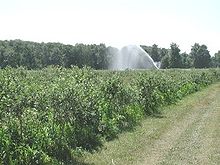
Sprinkler irrigation of blueberries in Plainville, New York, United States
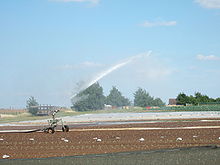
A traveling sprinkler at Millets Farm Centre, Oxfordshire, United Kingdom
Further information: Irrigation sprinkler
In sprinkler or overhead irrigation, water is piped to one or more central locations within the field and distributed by overhead high-pressure sprinklers or guns. A system utilizing sprinklers, sprays, or guns mounted overhead on permanently installed risers is often referred to as a solid-set irrigation system. Higher pressure sprinklers that rotate are called rotors an are driven by a ball drive, gear drive, or impact mechanism.
Other travelers use a flat rubber hose that is dragged along behind while the sprinkler platform is pulled by a cable. These cable-type travelers are definitely old technology and their use is limited in today's modern irrigation projects.
Irrigation using Center pivot
A small center pivot system from beginning to end
The hub of a center-pivot irrigation system
Rotator style pivot applicator sprinkler
Center pivot with drop sprinklers
Wheel line irrigation system in Idaho, 2001
Center pivot irrigation
Center pivot irrigation is a form of sprinkler irrigation consisting of several segments of pipe (usually galvanized steel or aluminium) joined together and supported by trusses, mounted on wheeled towers with sprinklers positioned along its length. The system moves in a circular pattern and is fed with water from the pivot point at the center of the arc. These systems are found and used in all parts of the world and allow irrigation of all types of terrain. Newer systems have drop sprinkler heads as shown in the image that follows.
Most center pivot systems now have drops hanging from a u-shaped pipe attached at the top of the pipe with sprinkler head that are positioned a few feet (at most) above the crop, thus limiting evaporative losses. Drops can also be used with drag hoses or bubblers that deposit the water directly on the ground between crops. Crops are often planted in a circle to conform to the center pivot. This type of system is known as LEPA (Low Energy Precision Application). Originally, most center pivots were water powered. These were replaced by hydraulic systems (T-L Irrigation) and electric motor driven systems (Reinke, Valley, Zimmatic). Many modern pivots feature GPS devices.
Irrigation by Lateral move (side roll, wheel line, wheel-move)
A series of pipes, each with a wheel of about 1.5 m diameter permanently affixed to its midpoint, and sprinklers along its length, are coupled together. Water is supplied at one end using a large hose. After sufficient irrigation has been applied to one strip of the field, the hose is removed, the water drained from the system, and the assembly rolled either by hand or with a purpose-built mechanism, so that the sprinklers are moved to a different position across the field. The hose is reconnected. The process is repeated in a pattern until the whole field has been irrigated.
This system is less expensive to install than a center pivot, but much more labor-intensive to operate - it does not travel automatically across the field: it applies water in a stationary strip, must be drained, and then rolled to a new strip. Most systems use 4 or 5-inch (130 mm) diameter aluminum pipe. The pipe doubles both as water transport and as an axle for rotating all the wheels.
Sub-irrigation
Sub-irrigation has been used for many years in field crops in areas with high water tables. It is a method of artificially raising the water table to allow the soil to be moistened from below the plants' root zone. Often those systems are located on permanent grasslands in lowlands or river valleys and combined with drainage infrastructure. A system of pumping stations, canals, weirs and gates allows it to increase or decrease the water level in a network of ditches and thereby control the water table.
Sub-irrigation is also used in commercial greenhouse production, usually for potted plants. Water is delivered from below, absorbed upwards, and the excess collected for recycling. Typically, a solution of water and nutrients floods a container or flows through a trough for a short period of time, 10–20 minutes, and is then pumped back into a holding tank for reuse. Sub-irrigation in greenhouses requires fairly sophisticated, expensive equipment and management.
Irrigation Automatically, non-electric using buckets and ropes
Besides the common manual watering by bucket, an automated, natural version of this also exists. Using plain polyester ropes combined with a prepared ground mixture can be used to water plants from a vessel filled with water.
The ground mixture would need to be made depending on the plant itself, yet would mostly consist of black potting soil, vermiculite and perlite. This system would (with certain crops) allow to save expenses as it does not consume any electricity and only little water (unlike sprinklers, water timers, etc.). However, it may only be used with certain crops (probably mostly larger crops that do not need a humid environment; perhaps e.g. paprikas).
Irrigation using water condensed from humid air
In-ground irrigation
Most commercial and residential irrigation systems are "in ground" systems, which means that everything is buried in the ground. With the pipes, sprinklers, emitters (drippers), and irrigation valves being hidden, it makes for a cleaner, more presentable landscape without garden hoses or other items having to be moved around manually. This does, however, create some drawbacks in the maintenance of a completely buried system.
Most irrigation systems are divided into zones. A zone is a single irrigation valve and one or a group of drippers or sprinklers that are connected by pipes or tubes.
Water sources
Irrigation is underway by pump-enabled extraction directly from the Gumti, seen in the background, in Comilla, Bangladesh.
Irrigation water can come from groundwater (extracted from springs or by using wells), from surface water (withdrawn from rivers, lakes or reservoirs) or from non-conventional sources like treated wastewater, desalinated water or drainage water. A special form of irrigation using surface water is spate irrigation, also called floodwater harvesting.
Modern irrigation methods are efficient enough to supply the entire field uniformly with water, so that each plant has the amount of water it needs, neither too much nor too little.[39] Water use efficiency in the field can be determined as follows:
• Field Water Efficiency (%) = (Water Transpired by Crop ÷ Water Applied to Field) x 100
Until 1960s, the common perception was that water was an infinite resource. At that time, there were fewer than half the current number of people on the planet.
Technical challenges
Main article: Environmental impact of irrigation
Irrigation schemes involve solving numerous engineering and economic problems while minimizing negative environmental impact.
• Competition for surface water rights.
• Overdrafting (depletion) of underground aquifers.
• Ground subsidence (e.g. New Orleans, Louisiana)
• Underirrigation or irrigation giving only just enough water for the plant (e.g. in drip line irrigation) gives poor soil salinity control which leads to increased soil salinity with consequent buildup of toxic salts on soil surface in areas with high evaporation. This requires either leaching to remove these salts and a method of drainage to carry the salts away. When using drip lines, the leaching is best done regularly at certain intervals (with only a slight excess of water), so that the salt is flushed back under the plant's roots.
• Overirrigation because of poor distribution uniformity or management wastes water, chemicals, and may lead to water pollution.
• Deep drainage (from over-irrigation) may result in rising water tables which in some instances will lead to problems of irrigation salinity requiring watertable control by some form of subsurface land drainage.
• Irrigation with saline or high-sodium water may damage soil structure owing to the formation of alkaline soil
• Clogging of filters: It is mostly algae that clog filters, drip installations and nozzles. UV and ultrasonic method can be used for algae control in irrigation systems.


